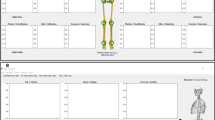Abstract
We propose an interactive visualization and reconstruction system for gait pattern analysis that creates a more realistic visualization of the patient than contemporary stick figure-like representations. It supports thorough gait pattern analysis, and enables unbiased inter- and intra-patient comparisons as well as longitudinal studies. Our system takes as input 3D motion capture data, but can be further constrained using readily available metadata or layman-accessible measurements. A statistical shape model is then fitted to the motion capture and personal metadata. The result is an immediate and interactive visualization of an animated 3D twin. Our system handles different marker setups and can thus be applied to already existing data. We further show that we can infer realistic body models with only a few of markers. A survey with medical experts confirms the clinical applicability of our method.
Access this chapter
Tax calculation will be finalised at checkout
Purchases are for personal use only
Similar content being viewed by others
References
Anguelov, D., Srinivasan, P., Koller, D., Thrun, S., Rodgers, J., Davis, J.: Scape: shape completion and animation of people. ACM Trans. Graph. 24(3), 408-416 (2005). https://doi.org/10.1145/1073204.1073207
Bogo, F., Romero, J., Pons-Moll, G., Black, M.J.: Dynamic FAUST: registering human bodies in motion. In: IEEE Conference on Computer Vision and Pattern Recognition (CVPR), July 2017
Cheng, Z.Q., Chen, Y., Martin, R.R., Wu, T., Song, Z.: Parametric modeling of 3D human body shape-a survey. Comput. Graph. 71, 88–100 (2018). https://doi.org/10.1016/j.cag.2017.11.008. https://www.sciencedirect.com/science/article/pii/S0097849317301929
Choutas, V., Müller, L., Huang, C.H.P., Tang, S., Tzionas, D., Black, M.J.: Accurate 3D body shape regression using metric and semantic attributes. In: Proceedings IEEE Conference on Computer Vision and Pattern Recognition (CVPR) (2022)
Delp, S.L., et al.: OpenSim: open-source software to create and analyze dynamic simulations of movement. IEEE Trans. Biomed. Eng. 54(11), 1940–1950 (2007)
Graham, R.: An efficient algorithm for determining the convex hull of a finite planar set. Inf. Process. Lett. 1(4), 132–133 (1972). https://doi.org/10.1016/0020-0190(72)90045-2. https://www.sciencedirect.com/science/article/pii/0020019072900452
Guo, H., Planche, B., Zheng, M., Karanam, S., Chen, T., Wu, Z.: SMPL-A: modeling person-specific deformable anatomy. In: Proceedings of the IEEE/CVF Conference on Computer Vision and Pattern Recognition (CVPR), pp. 20814–20823, June 2022
Heymsfield, S.B., Wang, J., Kehayias, J., Heshka, S., Lichtman, S., Pierson, R.N.: Chemical determination of human body density in vivo: relevance to hydrodensitometry. Am. J. Clin. Nutr. 50(6), 1282–1289 (1989). https://doi.org/10.1093/ajcn/50.6.1282. https://www.sciencedirect.com/science/article/pii/S0002916523437021
Keller, M., et al.: From skin to skeleton: towards biomechanically accurate 3d digital humans. In: ACM ToG, Proceedings of the SIGGRAPH Asia, vol. 42, December 2023
Keller, M., Zuffi, S., Black, M.J., Pujades, S.: OSSO: obtaining skeletal shape from outside. In: Proceedings IEEE/CVF Conference on Computer Vision and Pattern Recognition (CVPR), pp. 20492–20501, June 2022
Kingma, D.P., Ba, J.: Adam: a method for stochastic optimization. Published as a conference paper at the 3rd International Conference for Learning Representations, San Diego 2015 (2014). https://arxiv.org/abs/1412.6980
Loper, M., Mahmood, N., Romero, J., Pons-Moll, G., Black, M.J.: SMPL: a skinned multi-person linear model. ACM Trans. Graphics (Proc. SIGGRAPH Asia) 34(6), 248:1–248:16 (2015)
Osman, A.A.A., Bolkart, T., Black, M.J.: STAR: sparse trained articulated human body regressor. In: Vedaldi, A., Bischof, H., Brox, T., Frahm, J.-M. (eds.) ECCV 2020. LNCS, vol. 12351, pp. 598–613. Springer, Cham (2020). https://doi.org/10.1007/978-3-030-58539-6_36. https://star.is.tue.mpg.de
Osman, A.A.A., Bolkart, T., Tzionas, D., Black, M.J.: SUPR: a sparse unified part-based human body model. In: Avidan, S., Brostow, G., Cissé, M., Farinella, G.M., Hassner, T. (eds.) ECCV 2022. LNCSS, vol. 13662, pp. 568–585. Springer, Cham (2022). https://doi.org/10.1007/978-3-031-20086-1_33. https://supr.is.tue.mpg.de
Pavlakos, G., et al.: Expressive body capture: 3D hands, face, and body from a single image. In: Proceedings IEEE Conference on Computer Vision and Pattern Recognition (CVPR), pp. 10975–10985 (2019)
Pujades, S., et al.: The virtual caliper: rapid creation of metrically accurate avatars from 3D measurements. IEEE Trans. Visual Comput. Graphics 25(5), 1887–1897 (2019). https://doi.org/10.1109/TVCG.2019.2898748
Schleicher., R., et al.: BASH: biomechanical animated skinned human for visualization of kinematics and muscle activity. In: Proceedings of the 16th International Joint Conference on Computer Vision, Imaging and Computer Graphics Theory and Applications (VISIGRAPP 2021) - GRAPP, pp. 25–36. INSTICC, SciTePress (2021). https://doi.org/10.5220/0010210600250036
Streuber, S., et al.: Body Talk: crowdshaping realistic 3D avatars with words. ACM Trans. Graph. (Proc. SIGGRAPH) 35(4), 54:1–54:14 (2016)
Wuhrer, S., Shu, C.: Estimating 3D human shapes from measurements. CoRR abs/1109.1175 (2011). http://arxiv.org/abs/1109.1175
Zhang, C., Chen, T.: Efficient feature extraction for 2D/3D objects in mesh representation. In: Proceedings 2001 International Conference on Image Processing (Cat. No.01CH37205), vol. 3, pp. 935–938 (2001). https://doi.org/10.1109/ICIP.2001.958278
Acknowledgements
This work was (partly) funded by the Deutsche Forschungsgemeinschaft (DFG, German Research Foundation) - SFB 1483 - Project-ID 442419336, EmpkinS.
Author information
Authors and Affiliations
Corresponding author
Editor information
Editors and Affiliations
Rights and permissions
Copyright information
© 2025 The Author(s), under exclusive license to Springer Nature Switzerland AG
About this paper
Cite this paper
Zieger, D. et al. (2025). 3D Body Twin: Improving Human Gait Visualizations Using Personalized Avatars. In: Wachinger, C., Paniagua, B., Elhabian, S., Luijten, G., Egger, J. (eds) Shape in Medical Imaging. ShapeMI 2024. Lecture Notes in Computer Science, vol 15275. Springer, Cham. https://doi.org/10.1007/978-3-031-75291-9_6
Download citation
DOI: https://doi.org/10.1007/978-3-031-75291-9_6
Published:
Publisher Name: Springer, Cham
Print ISBN: 978-3-031-75290-2
Online ISBN: 978-3-031-75291-9
eBook Packages: Computer ScienceComputer Science (R0)





